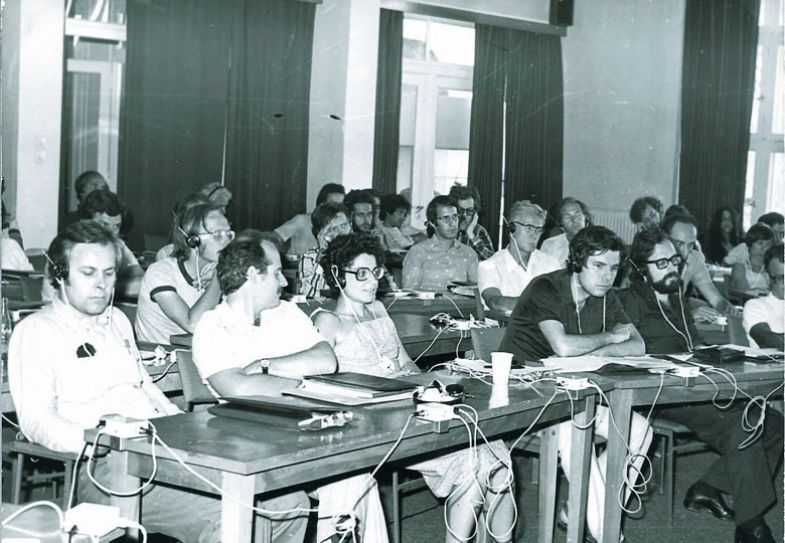“If there were two or three other Nobel prizewinners living in Italy, my life would be much simpler,” says Giorgio Parisi, joint winner of the 2021 physics prize, apologising for rescheduling our arranged Zoom call.
“There are quite a few Italian Nobel laureates,” continues the Sapienza University of Rome professor, “but I am the only one who lives in Italy. On any occasion that people think it might be nice to have a Nobel laureate, they always ask me, and often I can’t refuse.”
In the case of our interview, Parisi had been summoned to meet the Italian prime minister to discuss the Einstein Telescope, the proposed European gravitational wave detector that Sardinia is battling with the Meuse-Rhine Euregion (on the border of the Netherlands, Belgium and Germany) to host. Parisi has agreed to chair the Sardinian bid’s steering committee. The 74-year-old is also president of the planning committee for a new science museum in Rome, a member of the scientific committee of the Abdus Salam International Centre for Theoretical Physics in Trieste, and vice-president of the Accademia Nazionale dei Lincei, the Italian equivalent of the UK’s Royal Society.

Alongside all this, Parisi has found time to write a lively overview of his career, In a Flight of Starlings: The Wonder of Complex Systems (Allen Lane), which also seeks to address what it calls “a strong antiscientific tendency currently at work” – as seen in the widespread interest in astrology and homeopathy as well as anti-vax campaigns.
Part of the problem, it suggests, is that scientists sometimes present their work “as if it were a superior kind of sorcery, comprehensible only to initiates. In the face of a science perceived as inaccessible magic, non-scientists are pushed toward irrational beliefs. If science comes across as pseudo-magic, then why not opt for actual magic instead?” the book asks. As it is clearly not enough for scientists just to say “trust us”, the book sets out to describe the human side of science: how “scientists toil, doubt, succeed, and fail”.
Asked about the misconceptions he is keen to challenge, Parisi says that “scientists are, in a sense, members of the elite, part of political power structures, and serve the interests of those who give them money and not the interests of the general public. I think it’s important for people to realise that scientists try and understand things in the most accurate possible way, and that they change their minds. It takes a long time before they reach a consensus.”
Parisi’s book includes an amusing account of his early student days at Sapienza. When he began his studies in 1966, first- and second-year students were required to enter the university buildings through the back door and had no contact with those in any other year. Everything was shaken up by the occupations and sit-ins that took place in 1968. Old hierarchies disappeared, and this led, Parisi says, to “an opening-up of physics to new things”. Along with a greater interest in applied research, “people working in high-energy physics became interested in statistical mechanics [the study of systems via probabilistic analysis of the behaviour of their microscopic constituents]. There were some internal scientific reasons for that, but it was also driven by a sense that something had to change.”

This was a period that had seen significant expansion within the university sector. As a result, talented scientists could get permanent positions soon after graduation. Parisi himself got tenure in his lab at the age of 27 and a full professorship at 32. This is hardly imaginable today, something he suspects discourages more adventurous thinking. “If you want to look for new things, to open up new paths and so on, that is risky,” he says. “You don’t know if you’ll find anything – and this is dangerous if you don’t have tenure because it might affect whether you get a permanent position.”
Parisi’s Nobel win caught the imagination given that it honoured, among other things, his work on the way flocks of starlings change shape and direction, demonstrating how physicists can provide insights into phenomena many people are intrigued by but would be unable to explain. His book explains how his research team obtained unprecedented quantities of photographic footage from cameras placed on the roof of a Roman museum. After intensive analysis, they were able to develop “new ideas and new algorithms” that allowed them to “determine, within several hundredths of a second, the precise moment at which each individual bird begins to turn when the flock as a whole turns”.
At the time, Parisi recalls, such work generated a certain amount of hostility from biologists because “for centuries, it has been a field in which mathematics was not so important”. Yet the growth of bioinformatics and research to address the Covid pandemic, not to mention the Human Genome Project, have led to “quite strong cross-fertilisation between the different disciplines of physics and mathematics and biology. It took some time. These last 15 years have been very important,” he says. And now, some, though by no means all, universities are more “interested in people with interdisciplinary attitudes”, he believes.
Campus resource: Take your online teaching outside
Describing his starling research, Parisi makes frequent use of accessible everyday analogies. For example, the researchers were surprised to find that the density of birds at the edges of the flock was nearly 30 per cent greater than at the centre, yet this is something “a bit like what happens [near the doors] on crowded buses”, he explains.
It was “truly unexpected” to discover that “the interaction between starlings depends not so much on the general distance between them as on the connections between the closest birds”, but there is also a sense in which this is “only natural: if I go for a run with friends and we turn right, in order to keep pace while doing so, my attention is fixed on the runner nearest to me.” Although “with hindsight, this seems obvious”, it also reveals something significant about science, namely a distinct “lack of proportion between the effort needed to understand something for the first time” in physics or mathematics and “the simplicity and naturalness of the solution once all the required stages have been completed”.
Parisi’s career has been notable for some dramatic shifts between theoretical and experimental work, and topics ranging from animal behaviour to “phase transitions” (such as the way that water suddenly begins to turn into ice when its temperature is lowered just half a degree from 0.5ºC). At one point, while working on a problem concerned with elementary particles, he read a paper on a mathematical technique that he hoped would prove useful. But this focused on spin glasses – alloys made of noble metals, such as gold and silver, diluted with small amounts of iron – which have unusual magnetic properties.
Although Parisi had no previous interest in them, he decided to abandon his initial mathematical concerns and to concentrate on spin glasses themselves, the field he is now most famous for. Yet similar analytical techniques can also illuminate the results of interactions in many other kinds of “disordered system”, according to his book, whether the basic elements are “websites, financial traders, stocks and shares, people, animals [or] components of ecosystems”.
Would it still be possible today to have a career involving so many changes of track? It would be more difficult, Parisi responds, because “every discipline is much more advanced than it was 15 years ago. To understand what is at the frontier of knowledge takes one or two years longer…whereas once upon a time you could switch from one to another field by yourself because there weren’t so many things to be learned.”
Although scientific papers rarely mention how researchers reach their results, Parisi wants to draw back the curtain and reveal the often important role of chance, intuition and unconscious modes of thinking. He recalls an occasion when he was exploring a theory and genuinely did not know whether it was true or false. So he worked for a day trying to prove that it was true, got discouraged, then spent the next day trying to prove that it was false, and got discouraged again.
When you know or strongly suspect that something is true, he suggests, it is psychologically much easier, “because you just go in that direction and don’t stop, though it may take a lot of time”. An example is Fermat’s last theorem: the idea that there is no solution to the equation an + bn = cn when n is greater than 2. The theorem dates from 1637, but it was proved by the Oxford mathematician Sir Andrew Wiles only in the 1990s. “It took an incredible amount of effort which people wouldn’t have thought worthwhile if they hadn’t been convinced that the theorem is true,” Parisi says.
An even more striking example of how chance and psychological factors have an impact on science is the story of how Parisi let his first chance of a Nobel prize slip through his fingers when he was only 25. He was working at the European particle physics laboratory Cern in 1973 with the brilliant theoretical physicist Gerard ’t Hooft, and they were discussing some important results that put them on the verge of a breakthrough in the description of protons and other elementary particles. Just one key element was missing, which could have been supplied by incorporating Murray Gell-Mann’s idea that quarks, the building blocks of protons and neutrons, come in different “colours”.
Although he had hitherto been unsympathetic to this theory, Parisi was well aware of it and reflects in In a Flight of Starlings that “it would have been enough at that moment to have seen [Gell-Mann’s] name written somewhere (on a blackboard, for instance), or for someone to have casually mentioned Gell-Mann’s model at lunch or supper, for me to have been able to run to ’t Hooft with a cry of ‘Eureka!’ In a couple of days we would have done the checks, written it up, and sent it for publication.”
In the event, three other young scientists – David Gross, David Politzer and Frank Wilczek – made the essential connection a few months later. This marked the birth of quantum chromodynamics and eventually won them the 2004 Nobel Prize in Physics.
Fortunately, Parisi had the talent and determination to earn a second chance of glory and take his place as Italy’s go-to scientific sage. And while scientists are not always valued for their sagacity, Parisi’s vivid account of how they succeed and fail should certainly do something to cut through the hostility they often face.
POSTSCRIPT:
Print headline: A free-flying mind
Register to continue
Why register?
- Registration is free and only takes a moment
- Once registered, you can read 3 articles a month
- Sign up for our newsletter
Subscribe
Or subscribe for unlimited access to:
- Unlimited access to news, views, insights & reviews
- Digital editions
- Digital access to THE’s university and college rankings analysis
Already registered or a current subscriber? Login








